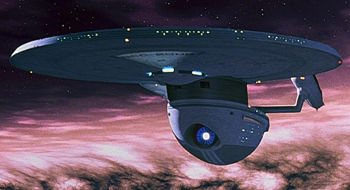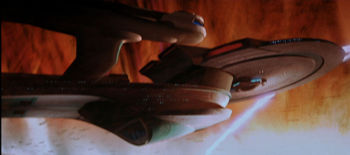Excelsior class

| Mk I[2] | Mk II[2][3] | MkIII[4] | Mk IV[5] | Mk V[6][7] | |
|---|---|---|---|---|---|
| Date Entered Service | Oct 2280 | Mar 2281 | 2284 | 2331 | Unk. |
| Number Constructed | 1 | 38 | Unk. | Unk. | Unk. |
| Length | 467m | 467m | 470m | 470m | 511.25m |
| Width | 186m | 186m | 266m[5] | 266m | 195.64m |
| Height | 78m | 78m | 111m[5] | 111m | 86.76m |
| Decks | Unk. | Unk. | 30 | 30 | 30 |
| Mass | 239,930mt | 243,610mt[2] / 239,645mt[3] | Unk. | Unk. | 2,350,000mt |
| Cargo Capacity | 27,500mt | 27,500mt[2] / 5,000mt[3] | Unk. | Unk. | Unk. |
| Computer Type | M-8 | M-8 | Unk. | Unk. | Unk. |
| Transporters (Personnel) | 6 | 6 | 4 | 4 | 4 |
| Transporters (Emergency) | 6 | 6 | 4 | 4 | 4 |
| Transporters (Cargo) | 3 | 3 | 5 | Unk. | 5 |
| Crew | 810 | 802 | 770 | 650 | 750 |
| Passengers | 40 | 40 | Unk. | Unk. | 130 |
| Evacuation Limit | Unk. | Unk. | 3,500 | Unk. | 9,800 |
| Shuttlecraft | 20 | 20 | 7[5] | 7 | Unk. |
| Cruising Speed | Warp 12 (OCU) | Warp 12 (OCU) | Warp 10 (OCU)[5] / Warp 9 (MCU) | Warp 9.2 (MCU) | Warp 9 (MCU) |
| Emergency Speed | Warp 14 (OCU) | Warp 14 (OCU) | Warp 13 (OCU)[5] / Warp 9.2 (MCU) for 12 hours | Warp 9.8 (MCU) | Warp 9.2 (MCU) for 12 hours |
| Weapons | 8 FH-11 Phasers in 4 banks; 8 FH-5 Phasers in 4 banks | 10 FH-11 Phasers in 5 banks | Type VIII Phasers | Type VIII Phasers | Type IX Phasers |
| 4 torpedo tubes | 6 torpedo tubes | 6 torpedo tubes[5] | 6 torpedo tubes | 4 torpedo tubes |

In October 2280, the U.S.S. Excelsior NX-2000, the first of a new class, was commissioned.[2] Originally designed as a test-bed for the experimental Transwarp drive, the Excelsior was called "The Great Experiment" by many in influential circles.[9] These ships were the newest in Starfleet and incorporated experimental technologies. With so many new systems aboard these vessels, the process of testing them was slow. Prior to being installed, each component was tested and retested until it met standards. Nevertheless, when the Excelsior was taken out for trials, the evaluation teams were constantly faced with primary system malfunctions that would not allow any of the secondary or backup systems to be tested. This caused the evaluators to deal with these new components on a one-at-a-time basis, thus creating time delays in the commissioning of the class.[2]
The Excelsior class underwent a number of late design changes when the transwarp project ultimately failed. While transwarp was never realized, designers were unwilling to cast aside what was otherwise a sound cruiser design. The transwarp engines were removed in favor of conventional warp drive engines. The Excelsior class could cruise at Warp 8 (OCU), sustain speeds of Warp 10 (OCU) for several hours, and reach Warp 13 (OCU) when necessary. This made it by far the fastest Starfleet vessel for almost five decades.[5]
After these changes were made, Starfleet built a second ship of the class, the U.S.S. Proxima NCC-2001, which finished her trials in December 2281 and was commissioned immediately thereafter. The U.S.S. Columbia NCC-2002, was completed in February 2281, while the U.S.S. Galacta NCC-2003 was commissioned in June 2282. All of these ships were constructed at shipyards orbiting Earth and Mars.[2][3]
A state-of-the-art capital ship with impressive size, speed, and tactical characteristics, the Excelsior class was well-suited for a number of mission roles. Specializing in emergency response and long-range exploration, the Excelsior class also distinguished itself through superior firepower and the ability to project force into neighboring sectors. They served as the mainline fleet vessel for Starfleet after the retirement of the Constitution class, and before the wide-scale use of Ambassdor class ships. They frequently operated as command and control vessels, dictating fleet actions. A number of scientific laboratories and the ability to launch long-range probes also made the class viable for exploration and scientific missions. As a support vessel, the ship's sensor capabilities were average for its class, while its operations and computer systems were top of the line. A large shuttlebay and ample cargo room gave the class the ability to operate in a number of auxiliary roles, such as colony supply, emergency relief, and deep-space surveying missions.[5]
The flagship of Starfleet, the U.S.S. Enterprise NCC-1701-B, was commissioned as an Excelsior class vessel,[3][10][8] while the Excelsior herself went on to a fine and distinguished career under Captain Hikaru Sulu.[1] The U.S.S. Gorkon NCC-40521 and U.S.S. Cairo NCC-42136, commanded by Captains Nechayev and Jellico, respectively, saw extensive action against the Tholians and Cardassians in a number of conflicts.[5]
Tactically, the Excelsior class was the most powerful Starfleet vessel fielded during the 23rd and early 24th centuries. Mounting several Type-VIII phaser banks, the Excelsior's firepower provided it with excellent strike capabilities. The addition of Mk 22 direct-fire photon torpedoes allowed the class to lay down multiple fields of fire. Supplemented by the proven CIDSS-2 shield system, the class enjoyed significant combat endurance.[5]
During the Cardassian and Dominion wars, the Excelsior class was an oft-seen combatant on the front lines. Excelsior class cruisers fought at the Chin'toka, Archanis, and Bolian sectors, to name a few, in the latter parts of the Dominion War.[5]
Excelsior class vessels
- U.S.S. Achilles NCC-2011
- U.S.S. Agincourt NCC-2014
- U.S.S. Agincourt NCC-38762
- U.S.S. Al-Batani NCC-42995
- U.S.S. Alamo NCC-2035
- U.S.S. Aquila NCC-2028
- U.S.S. Arizona NCC-2012
- U.S.S. Bearn NCC-2027
- U.S.S. Berlin NCC-14232
- U.S.S. Brisbane NCC-2030
- U.S.S. Cairo NCC-42136
- U.S.S. Challenger NCC-2023
- U.S.S. Charleston NCC-42285
- U.S.S. Chikuma NCC-2008
- U.S.S. Columbia NCC-2002
- U.S.S. Constitution NCC-2025
- U.S.S. Crazy Horse NCC-50446
- U.S.S. Crockett NCC-38955
- U.S.S. de Mayo NCC-2029
- U.S.S. Eagle NCC-2031
- U.S.S. Enterprise NCC-1701-B
- U.S.S. Excalibur NCC-2004
- U.S.S. Excelsior NCC-2000
- U.S.S. Excelsior NCC-2000 (Alt)
- I.S.S. Excelsior NCC-2000
- U.S.S. Exeter NCC-2016
- U.S.S. Farragut NCC-2582
- U.S.S. Fearless NCC-2036
- U.S.S. Fearless NCC-14598
- U.S.S. Fredrickson
- U.S.S. Fuso NCC-2019
- U.S.S. Galacta NCC-2003
- U.S.S. Gorkon NCC-40512
- U.S.S. Grissom NCC-42857
- U.S.S. Hancock NCC-2006
- U.S.S. Hood NCC-2017
- U.S.S. Hood NCC-42296
- U.S.S. Intrepid NCC-2020
- U.S.S. Intrepid NCC-38907
- U.S.S. Jackson
- U.S.S. Kitty Hawk NCC-2007
- U.S.S. Kongo NCC-2009
- U.S.S. Lakota NCC-42768
- U.S.S. Lexington NCC-2026
- U.S.S. Lexington NCC-14427
- U.S.S. Livingston NCC-34099
- U.S.S. Malinche NCC-38997
- U.S.S. Melbourne NCC-62043
- U.S.S. Okinawa NCC-13958
- U.S.S. Potemkin NCC-2005
- U.S.S. Potemkin NCC-18253
- U.S.S. Proxima NCC-2001
- U.S.S. Repulse NCC-2544
- U.S.S. Roosevelt NCC-2573
- U.S.S. Royal Oak NCC-2013
- U.S.S. Ryujo NCC-2022
- U.S.S. Sussex NCC-2024
- U.S.S. Tecumseh NCC-14934
- U.S.S. Thunderer
- U.S.S. Ticonderoga NCC-2034
- U.S.S. Valiant NCC-2018
- U.S.S. Valley Forge NCC-43305
- U.S.S. Yamashiro NCC-2015
- U.S.S. Yorktown NCC-2033
References
- ↑ 1.0 1.1 Star Trek VI: The Undiscovered Country. Film. 6 December 1991.
- ↑ 2.0 2.1 2.2 2.3 2.4 2.5 2.6 "Federation Ship Recognition Manual." Star Trek: The Roleplaying Game, Supplement 2302. Game. 1985. FASA.
- ↑ 3.0 3.1 3.2 3.3 3.4 "Star Trek: The Next Generation Officer's Manual." Star Trek: The Roleplaying Game, Supplement 2012. Game. 1988. FASA.
- ↑ "Core Game Book." Star Trek: The Next Generation Roleplaying Game, Supplement 25000. Game. August 1998. Last Unicorn Games, Inc.
- ↑ 5.00 5.01 5.02 5.03 5.04 5.05 5.06 5.07 5.08 5.09 5.10 5.11 "Starships." Star Trek Roleplaying Game, Book 4. Game. 2003. Decipher, Inc.
- ↑ "Star Trek: Deep Space Nine Technical Manual." Book. November 1998. Pocket Books.
- ↑ "Core Game Book." Star Trek: Deep Space Nine Roleplaying Game, Supplement 35000. Game. 1999. Last Unicorn Games, Inc.
- ↑ 8.0 8.1 Star Trek: Generations. Film. 18 November 1994.
- ↑ Star Trek III: The Search for Spock. Film. 1 June 1984.
- ↑ "Star Trek: The Next Generation Technical Manual." Book. November 1991. Pocket Books.